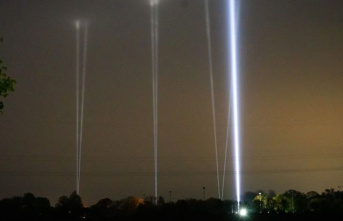With the awakening of the La Palma volcano, an old fear was reactivated, which has accompanied palmeros for decades. Is the volcanic edifice of Cumbre Vieja stable? Could the northern flank of the island collapse? Experts feared a "catastrophic collapse" of part of the cone, which did not occur. The cracks of the last days of activity could have been the key that avoided the tragedy.
The stability of the west flank of the island has been under study for dozens of years, with evaluations that have even estimated the destructive capacity that this landslide would have: A large tsunami that would cross the Atlantic. Experts have cleared up this concern in society in a recent publication by researchers Mercedes Ferrer, Senior Researcher at the IGME-CSIC, and Luís González de Vallejo, Honorary Professor at the Complutense University of Madrid (UCM) and director of the Volcanic Risks area of the Volcanological Institute of the Canary Islands (Involcán) in the prestigious magazine 'Science', where they have confirmed that the Cumbre Vieja building is mechanically stable in the long term.
This building is firm beyond human scale, meaning it will outlast current palm trees, regardless of the volcano-structural features associated with the recent 2021 Cumbre Vieja eruption, which sparked this historic threat, they have said.
With the eruption of the unnamed volcano at Cumbre Vieja, the possibility of a partial collapse was raised, a 'collapse' of part of the cone that ultimately did not occur on a large scale. The eruption, which began on September 19, 2021 and ended after 85 days and 8 hours, was the longest and most voluminous eruption on La Palma. With more than 200 million cubic meters of lava and a VEI3 explosiveness index, it set off the alarms, as scientists recall in the journal 'Science'.
On October 3, 8 and 23, 2021, part of the cone collapsed, creating new flow routes and erratic blocks the size of three-story buildings that came down the slopes. The idea of a general collapse frightened the island.
As they explain in the scientific article, a key research question remains why this eruption did not create a catastrophic collapse of the volcano's flank, as perhaps expected. The answer may be linked to its different volcanic-tectonic characteristics and, in particular, to an "unexpected fissure system that opened during the last phase of the eruption."
These cracks were seen by society, thanks to the monitoring and information shared day by day by seismologists, geologists and volcanologists on the ground. The director of the IGN, María José Blanco, like her colleague Carmen López and Stavros Meletlidis, read in their daily Pevolca report that "a partial collapse of the cone could occur" and before the appearance of fissures they called for calm, anticipating that if it occurs it would be towards the interior of the cone, and not the other way around.
The cracks and fractures were recorded in the last days of the volcano, in early December. At that time, the director of the Central Geophysical Observatory of the National Geographic Institute (IGN) and spokesperson for the Pevolca scientific committee (Canary Islands Volcanic Emergency Plan (Pevolca), Carmen López, explained that they could evolve and cause landslides and collapses inside the crater, that is, with a local effect that would not compromise the stability of the volcanic edifice, since they only appeared in the upper zone of the northeastern sector of the main edifice.
Due to good monitoring effort, this eruption will allow the testing of a wide range of scientific ideas, from the importance of a possible 436-year supercycle of eruptions of decreasing duration to the use of geophysical observations to understand how magma is stored and migrates. within a vertically extending upper mantle and crustal magmatic system. These types of magmatic and volcanological information will transform volcanic eruption risk assessment and long-term planning.
Part of this valuable information has been transferred by the Involcán teams to the island of São Jorge in the Azores (Portugal), who traveled to the island to help monitor and follow up the activity in the face of the possibility of an imminent eruption.
2












